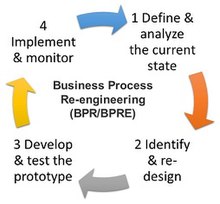
Back إعادة هندسة الأعمال Arabic Business Process Reengineering German Επανασχεδιασμός επιχειρησιακών διεργασιών Greek Reingeniería de procesos Spanish بازمهندسی فرایند کسب و کار Persian Réingénierie des processus d'affaires French Բիզնես գործընթացների վերակառուցում Armenian Rekayasa ulang proses bisnis ID Riprogettazione dei processi aziendali Italian ビジネスプロセス・リエンジニアリング Japanese

Business process re-engineering (BPR) is a business management strategy originally pioneered in the early 1990s, focusing on the analysis and design of workflows and business processes within an organization. BPR aims to help organizations fundamentally rethink how they do their work in order to improve customer service, cut operational costs, and become world-class competitors.[1]
BPR seeks to help companies radically restructure their organizations by focusing on the ground-up design of their business processes. According to early BPR proponent Thomas H. Davenport (1990), a business process is a set of logically related tasks performed to achieve a defined business outcome. Re-engineering emphasized a holistic focus on business objectives and how processes related to them, encouraging full-scale recreation of processes, rather than iterative optimization of sub-processes.[1] BPR is influenced by technological innovations as industry players replace old methods of business operations with cost-saving innovative technologies such as automation that can radically transform business operations.[2]
Business process re-engineering is also known as business process redesign, business transformation, or business process change management.
- ^ a b Business Process Re-engineering Assessment Guide, United States General Accounting Office, May 1997.
- ^ Subramoniam, S., 2008. Commanding the internet era. Industrial Engineer, pp.44-48.
© MMXXIII Rich X Search. We shall prevail. All rights reserved. Rich X Search